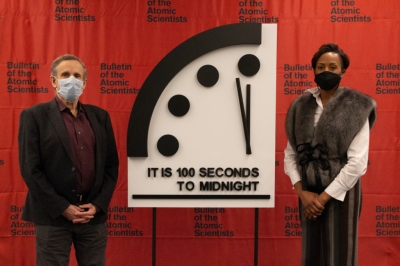
On January 20, 2022, the Bulletin of the Atomic Scientists announced that the Doomsday Clock was reset to 100 seconds (1 minute 40 seconds) before midnight. Midnight on the clock symbolises the end of the world. The decision came as a result of continued concern over nuclear weapons, climate change, the pandemic and the failure of governments and international organisations to respond in productive ways.
Over the years, the clock’s hands have moved forwards and backwards as the threats to the world kept changing. From 2020, they have been 100 seconds to midnight due to threats from nuclear war, climate change and the pandemic. Why does this matter?
What is the Doomsday Clock?
The Doomsday Clock is a symbolic clock that represents the likelihood of a man-made apocalypse. It warns humanity of how close the world is to catastrophe every year. The concept is simple – the closer the time is to midnight, the closer the world is to destruction. The Doomsday Clock is a universally recognised metaphor.
How did the Doomsday Clock tradition begin?
The Doomsday Clock was created in 1947 in response to the growing threat of a nuclear war between the U.S. and the Soviet Union (today’s Russia). The Clock’s original setting then was seven minutes to midnight. The idea of the Doomsday Clock was conceived by an international group of researchers called the Chicago Atomic Scientists, who had been involved with the Manhattan Project, which made the first nuclear weapons. The scientists regularly brought out a bulletin detailing updates in nuclear weaponry. The board of the Bulletin of the Atomic Scientists (BAS) designed the clock as an illustration for the cover of the first edition of the bulletin. The Clock had been depicted on every cover of the bulletin until the publication became digital. The Clock is now featured as part of the logo on the bulletin’s website.
Who decides the time?
The decision to move (or to leave in place) the minute hand of the Doomsday Clock is made every year by the Bulletin’s Science and Security Board in consultation with its Board of Sponsors, which includes 13 Nobel laureates. The Board meets twice a year to reflect on international events considered dangerous to mankind and reset the clock accordingly every January.
What is the basis on which the time is set?
While climate change and the nuclear threat remain the main factors to determine the time, the panel of scientists in the bulletin also considers disruptive technologies such as cyber warfare, Artificial Intelligence and gene editing as potential threats. Biosecurity, bioterrorism, and dangers of fake news have also been considered. The bulletin considered possible catastrophic disruptions from climate change for the first time in 2007.
What is the reason behind the current time?
The scientists panel said that their decision was based on the war-like situation between Russia and Ukraine, the ongoing climate disaster and the coronavirus pandemic
The panel is concerned over the nuclear modernisation and expansion efforts of the U.S., Russia, China, and North Korea. “Ukraine remains a potential flashpoint, and Russian troop deployments to the Ukrainian border heighten day-to-day tensions,” read the release from the Bulletin of the Atomic Scientists. As for climate action, it said there exists a huge gap still between long-term greenhouse gas-reduction pledges and emission-reduction actions needed to achieve those goals. It also said that the worldwide response against the COVID-19 pandemic in 2021 remained entirely insufficient. Plans for quick global distribution of vaccines essentially collapsed, leaving poorer countries largely unvaccinated and allowing new variants of the SARS-CoV-2 virus to gain an unwelcome foothold.
In view of this mixed threat environment, where positive developments are counteracted by worrisome trends, the members of the Bulletin of the Atomic Scientists find the world to be no safer than it was last year at this time.
Picture Credit : Google
Leave a Reply